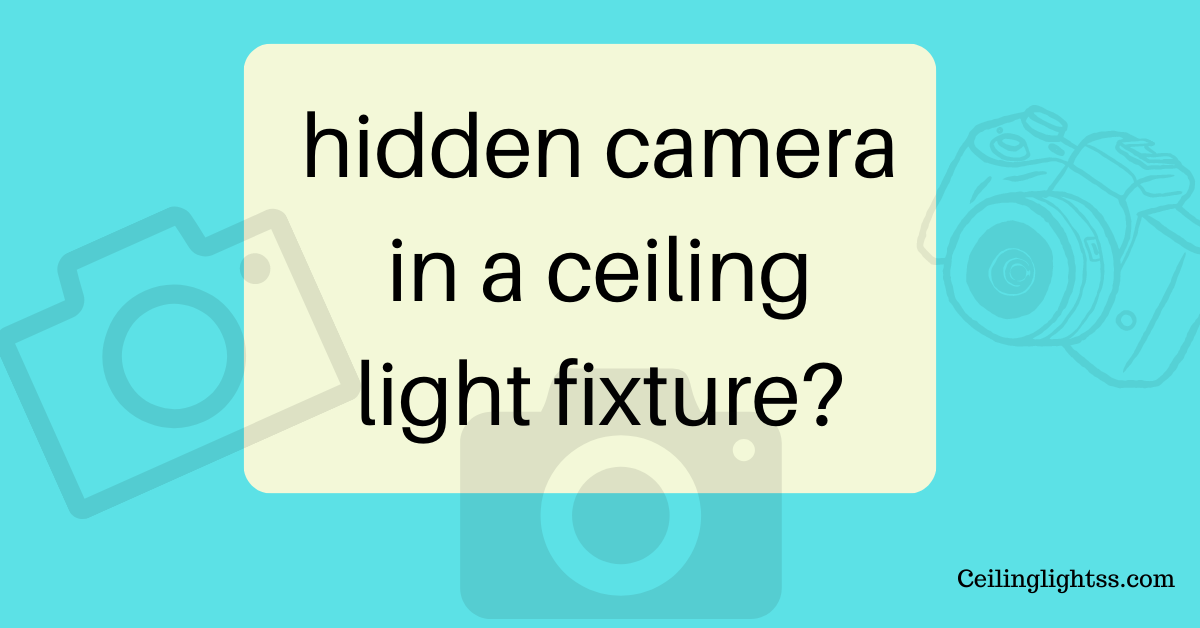Installing a camera in a ceiling light fixture involves several steps and considerations. However, I want to reiterate the importance of using such devices ethically and within the boundaries of the law. Always respect privacy and ensure that you’re installing cameras for legitimate reasons. If you’re unsure, it’s best to consult legal professionals.
Assuming you’re looking for general guidance on how to install a camera in a ceiling light fixture, here’s a basic outline:
Materials Needed:
- Camera unit – CHECK AMAZON
- Ceiling light fixture with enough space to accommodate the camera – CHECK AMAZON
- Screwdriver and screws
- Electrical tape
- A power source (if the camera requires it)
Steps:
- Choose the Right Location: Select a suitable location for the camera. It should have a clear view of the area you want to monitor. Ensure the ceiling fixture has enough space to house the camera without obstructing its lens.
- Turn Off Power: Before starting any work, turn off the power to the light fixture at the circuit breaker to ensure safety.
- Remove Existing Fixture: Carefully remove the existing ceiling light fixture. This usually involves unscrewing the institution from the ceiling and disconnecting any wiring. Follow proper safety procedures and, if unsure, consider seeking help from an electrician.
- Prepare the Camera: You might need to connect it to a power source depending on the camera type. Some cameras are wireless and run on batteries, while others might need to be wired to an electrical connection.
- Position the Camera: Place the camera inside the light fixture housing in a way that its lens is unobstructed and pointing in the desired direction. Ensure the camera is securely mounted.
- Wiring (If Required): If your camera needs a power source, ensure you have the necessary wiring. You might need to route the wires through the fixture’s openings. Follow the manufacturer’s instructions for wiring and connections. If you’re not comfortable with electrical work, consider hiring a professional.
- Secure the Camera: Fix the camera in place using screws or brackets provided by the manufacturer. Ensure it’s stable and won’t come loose.
- Reconnect Wiring: If you disconnect any wires to remove the existing fixture, carefully reconnect them following proper wiring practices. Make sure wire connections are secure and insulated with electrical tape.
- Mount the Fixture: Hold the fixture back on the ceiling and secure it using screws.
- Turn On Power: Once the camera is installed and the fixture is securely mounted, you can turn the power back on at the circuit breaker.
- Test the Camera: Test the camera to ensure it’s functioning as expected and capturing the desired area.
Remember, the process can vary based on the camera model and the specifics of your ceiling light fixture. If you’re not comfortable with electrical work or if you’re unsure about any step, it’s recommended to seek professional assistance to ensure safety and proper installation. Additionally, always ensure you’re abiding by relevant laws and respecting privacy considerations.
Read: Enhancing Spaces with Suspended Ceiling Light Fixtures
What is a hidden camera?
A hidden camera, also known as a covert camera or spy camera, is a type of surveillance device designed to record or capture video footage without being easily noticeable or detectable by people in the vicinity. Hidden cameras are often used for security, monitoring, or investigative purposes. They come in various forms and sizes, and their primary purpose is to discreetly record events or activities without drawing attention.
These cameras can be concealed within common objects or locations, making them challenging to spot. Some examples of where hidden cameras might be placed include clocks, smoke detectors, pens, clothing accessories, or even household items like light fixtures, as you previously mentioned.
It’s important to note that the use of hidden cameras is subject to legal and ethical considerations. While they can serve legitimate security purposes, their usage in private spaces or without the consent of individuals being recorded can infringe on privacy rights and laws in many jurisdictions. Always make sure to use hidden cameras responsibly and within the confines of relevant legal guidelines.
What are the some benefits of adding a camera to a ceiling light fixture
Adding a camera to a ceiling light fixture can offer several potential benefits, particularly in terms of security and monitoring. Here are some advantages to consider:
- Discreet Surveillance: A hidden camera within a ceiling light fixture can provide discreet monitoring without drawing attention. This can be particularly useful in situations where overt cameras might be tampered with or avoided by individuals engaging in suspicious activities.
- Unobstructed View: Placing a camera in a ceiling light fixture can offer an unobstructed view of the area you want to monitor. This vantage point might capture activities that would be difficult to record using traditional cameras at eye level.
- Reduced Vandalism: Because hidden cameras are less likely to be noticed, they are less susceptible to vandalism or tampering. This can help maintain the integrity of the surveillance system.
- Enhanced Security: Hidden cameras can complement visible security measures by capturing footage that might go unnoticed by potential intruders. They can provide an additional layer of security in areas where overt cameras might not be suitable.
- Evidence Collection: In cases of criminal activity or disputes, hidden cameras can provide valuable evidence that can aid in investigations and legal proceedings. High-quality footage from an inconspicuous camera can offer crucial insights.
- Remote Monitoring: Many hidden cameras are connected to networks, enabling remote monitoring via smartphones or computers. This can provide real-time updates and the ability to check on the monitored area from anywhere.
- Customization: Hidden cameras can often be integrated into existing structures and fixtures, allowing for customized positioning and coverage tailored to your specific security needs.
- Minimal Deterrence Impact: In some scenarios, visible cameras might deter certain behaviors or activities, but hidden cameras can be strategically placed to capture more candid and genuine reactions or actions.
- Reduced Interference: Traditional security cameras might sometimes disrupt the aesthetics of a space or interfere with the environment. Hidden cameras can maintain the overall visual appeal while providing security benefits.
- Covert Investigation: In situations where suspicions arise, hidden cameras can be used to discreetly investigate without alerting potential wrongdoers. This can be useful for uncovering inappropriate behavior or confirming suspicions.
- Protection of Valuables: Placing a hidden camera in areas with valuable items can help monitor and protect these possessions from theft or damage.
While these benefits are noteworthy, it’s crucial to weigh them against the potential drawbacks and to prioritize ethical considerations, legality, and respect for privacy. Responsible and thoughtful implementation of hidden cameras, while considering these factors, can help maximize the advantages they offer.
What are the disadvantages of adding a camera to the ceiling light
Adding a camera to a ceiling light fixture can have several disadvantages and potential drawbacks. Here are some of the key disadvantages to consider:
- Privacy Concerns: Placing a camera in a ceiling light fixture, especially in private or sensitive areas, can raise significant privacy concerns. People might feel uncomfortable knowing that they are being recorded without their knowledge or consent.
- Legal Issues: Depending on your location and the specific circumstances, recording individuals without their consent might be illegal. Laws regarding surveillance and privacy vary widely, and using hidden cameras improperly can lead to legal consequences.
- Ethical Considerations: Even if it’s legal, it might not be ethically appropriate to record people without their knowledge. Respecting the privacy and autonomy of individuals is important.
- Trust Issues: If people discover that they are being recorded without their consent, it can lead to mistrust and discomfort in the environment. This can be especially problematic in places where people expect a certain level of privacy, such as homes, offices, or restrooms.
- Safety Hazards: Installing a camera in a ceiling light fixture might involve electrical wiring and modifications. If not done correctly, it could pose safety hazards like electrical shorts, fires, or physical harm during installation.
- Technical Limitations: Placing a camera within a ceiling light fixture might limit its field of view and angle. The camera might not capture the desired area effectively, reducing its overall utility for surveillance purposes.
- Maintenance Challenges: If the camera requires regular maintenance or adjustments, accessing it within the ceiling light fixture could be difficult and inconvenient.
- False Sense of Security: Relying solely on a hidden camera in a ceiling light might create a false sense of security. Cameras have limitations, and other security measures might be needed for comprehensive protection.
- Installation Complexity: Installing a camera in a ceiling light fixture can be technically challenging, especially if electrical work is involved. Incorrect installation could lead to damage, poor camera performance, or safety issues.
- Cost: Quality hidden cameras can be expensive, and if you require professional installation or additional equipment, the costs can add up quickly.
- Limited Coverage: Depending on the camera’s field of view and location, it might not capture all the areas you intend to monitor. Multiple cameras might be required for comprehensive coverage.
Before installing a hidden camera in a ceiling light fixture, it’s crucial to carefully weigh these disadvantages against the potential benefits. If security or monitoring needs exist, exploring transparent and legal camera installation options that prioritize consent and privacy is advisable.
Conclusion
In conclusion, the decision to add a hidden camera in a ceiling light fixture is a complex one that involves a careful balance of security, privacy, ethics, and legality. While hidden cameras can offer surveillance benefits, there are significant disadvantages to consider. Privacy concerns, legal ramifications, ethical considerations, and potential negative effects on trust within an environment are all important factors.
Respecting the privacy and rights of individuals should be a paramount consideration. The use of hidden cameras without proper consent can lead to discomfort, mistrust, and potential legal consequences. Before proceeding, it’s essential to research and understand the laws and regulations related to surveillance in your jurisdiction.
Furthermore, the technical challenges, installation complexity, and maintenance requirements associated with hidden cameras in ceiling light fixtures must not be underestimated. Safety hazards, limited coverage, and the risk of false security can all undermine the intended benefits.
Given these complexities, it’s recommended to explore alternative security measures that prioritize transparency, consent, and ethical considerations. Openly placed security cameras with visible indicators can deter unwanted behavior while respecting the rights of individuals within the monitored area.
Ultimately, any decision to install a hidden camera in a ceiling light fixture should be made after careful consideration of the potential drawbacks and the commitment to uphold the values of privacy and ethics in the pursuit of security.

